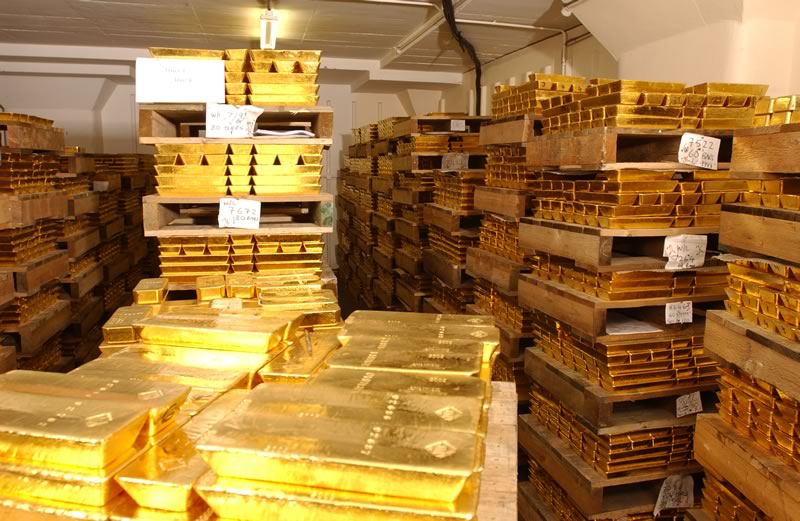
Posted on 12/09/2005 10:49:04 AM PST by Travis McGee
I recently came across a photo which purports to show nearly a billion dollars in privately owned gold bullion, in one vault. The gold bullion is supposed to be held in trust for shareholders who purchase ETFs or gold shares in this company. Be that as it may, I don't want this thread to turn into a discussion of precious metal ETFs, or the price of gold, or gold versus fiat money etc.
I just have some questions which only an engineer can answer. Does this picture physically "add up?"
I rough-count approx. 150 pallets in sight, with approx. 80 bars per pallet. At about 100# per ingot, six pallets high, that makes each stack of pallets weigh about 48,000 freaking pounds!!
On plain wooden pallets! Not special steel pallets, or some other custom pallet designed to hold a billion dollars worth of gold in one room.
I once handled 10,000 pounds of lead in 50# ingots (for a boat keel) and it was impressively heavy when stacked up! Gold as we know is much heavier than lead, almost double. (Gold's specific gravity = 19.32, Lead = 11.34)
So I have a few phsical questions civil engineers might want to tackle. Can you determine likelihood that the gold bars are real, from this photo, based on the pallet materials, pallet construction and orientation, and the weight and distribution of the alleged gold ingots?
This is what made me wonder, when first I examined the photo.
#1: Look at how most of the wooden pallets' edges overhang the stack of gold bars below them. That is, the vertical wood risers between the two flat wooden "floors" are not directly on top of the gold below them. The vertical wood riser in the center is, but the risers on the sides are hanging out over space. Much of the crushing weight of those thousands and thousands of pounds of (supposed) gold is held on the thin horizontal wooden "floors." I think it could be shown (even with lead bars in a test) that such pallets, stacked exactly that way, would crack apart under the cumulative weight of gold. The gold ingots do not completely span the space between the risers, that is, they do not rest their ends directly over the wooden risers on the sides of the pallets, putting the risers in simple compression.
The vertical wood beams would have to be under the gold to directly support the incredible weight, and not hanging out over the edges, over thin air. That is my layman's opinion, anyway, based on stacking and handling 200 bars of lead, weighing 50# each, once upon a time.
Question #2: How did the forklift load those top pallets? The ceiling of the vault is seems rather low for a forklift to get them up there. Don't forklifts need some clear space above them for high lifts? At least 3 or 4 or so extra feet, I'm guessing from memory. So, did they use forklifts to carry the approx. 8,000# pre-loaded pallets into the vault? That is the clear implication from the orientation of every single pallet facing their open sides toward the camera.
OTOH, if you were loading empty wooden pallets by hand, bar-by-bar, every warehouseman should know (this is "warehouse 101") to alternate the orientation of the pallets 90 degrees, each pallet, to vastly increase the stability of the overall stack of pallets. If a stack of pallets broke or collapsed (crushed the wood and tumbled sideways, because they were all oriented the same direction) it could kill somebody under the ensuing gold avalanche. Remember, each pallet stack of gold weighs approx. 48,000#, based on my estimate of 100# per bar (which may be way off.) Alternating pallet directions for stability is a basic practice, if they were loaded in place by hand, bar-by-bar, and not by forklift.
So the only reason all of the pallets would be oriented this way toward the camera, would be because they were brought into the vault by a forklift, and not bar-by-bar, by hand. If so, could a forklift place those top pallets up there, given the ceiling space above the top pallets? And if they were loaded in place, bar-by-bar, what warehouseman would not alternate the pallet orientation, for stability and safety?
These question only raised my suspicions about the pictures. Now, an engineer might be able to total up the weight of the gold bars, figure out the crushing /compression strength of the wood, figure out how much of the total stack weight is carried to the floor through the vertical risers, and how much is simply downward weight upon the unsupported horizontal wooden pallet floors, and determine if this is a possible photo of actual gold, or possibly something else.
Since I can't go and physically inspect the ingots in this vault, I'm just curious what engineers think about the credibility of the photo, based on the physical sciences.
Remember, this is gold held in trust for investors, who pay their money, but do not, as far as I can determine, get to visit the secret vault and inspect it.
Maybe an engineering professor can give this question to his students, as a test.


I disagree with you on that one. The plywood sheets aren't carrying the full load above them. You can't see this easily because the labels are in the way, but each pallet has another vertical support running down the middle of it. So it looks as if there are only about 12 inches between each support -- which means these pallets are not the typical industrial pallets you see in a warehouse.
I get that at $500 per troy ounce that the gold would occupy about 111 cubic feet of gold or a 10X11 room stacked one foot deep.
(((1e9 / 500) / 12) * (373 / 453.6)) / 64) / 19.3 = 110.955096
Assuming 12 troy ounces to the troy pound
373 grams/troy pound
453.6 grams per regular pound
one cubic foot of water =64 pounds
the density of gold is 19.3 times as much as water
The risers on these pallets look like 2x4 instead of 1x4, and the top & bottom look like 1x? instead of half x ?.
IOW the pallets are stronger than normal. Strong enough not to collapse under 6 tons?
Na. I'd say around 35-40 lbs each. (I got to hold one a while back --- just couldn't figure out how to stuff it in my pocket without that damn guard noticing.)
"Typical gold bar is 400 troy ounces"
Working from that figure, I get that there should be 5000 bars
(1e9 / 500) / 400 = 5 000
Notice how the first layer on each pallet is laid with or along the slats of the pallet whereby subjecting it's mass mostly to the large timbers making up the web of the pallet. The compressive strength of this hardwood, most likely red oak, is impressive and certainly can take the loading. Pallets like these routinely handle bricks and are not as well built and often used more than once breaking down each time. Although gold is denser, and the pallet is heavier, it seems to me that this picture is plausible.
If this is the vault for Barclay's Bank GLD shares I wouldn't worry about it. Barclay's makes a hell of a lot more than a billion dollars a year on its iShares products.
Actually, with the load being so evenly distributed, the wood should hold up. If you notice the horizontal boards do show some deflection. I will run the numbers later to see if the mechanics equations bear the same results, but I'm pretty sure they will. I load 300 hp motors onto wood palets all the time and that is a force of 400 lbs only over 16 in^2.
The gold stored in the Depository at Ft. Knox is in the form of standard mint bars of almost pure gold or coin gold bars resulting from the melting of gold coins. These bars are about the size of an ordinary building brick, but are somewhat smaller. The approximate dimensions are 7 x 3-5/8 x 1-3/4 inches. The fine gold bars contain approximately 400 troy ounces of gold. The avoirdupois weight of the bars is about 27-1/2 pounds. They are stored in the vault compartments without wrappings.
The load is largely transmitted to the floor through the beams on the sides and center of the pallets.
This puts 1/3 the entire weight of the entire stack above directly onto that edge, where the horizontal plywood floor meets the vertical riser. (1/3, because 1/3 is on the center vertical riser, and one third is on the opposite side vertical riser.)
This reduces the entire problem to a simple sheer strength equation. 1/3 of the entire weight of the stack above that point, against that plywood, in sheer.
Would it hold, or would it fail?
We need to know the exact weight of the gold above, and the sheer strength of the plywood.
I think that data should be right in a civil engineering text book, if we can make assumptions about the horizontal wood's compression, tensile and sheer strength.
Can't say about the gold, but I sympathize about the lead. Doing radiation tests I once stacked 1500 lead bricks at 30 lbs per brick.
I'm not so sure about that, or what % of the load is transmitted through the side beams. Looks more like a sheer strength situation to me, as laid out in my last reply.
""I rough-count approx. 150 pallets in sight, with approx. 80 bars per pallet"
Then that's twice as many bars as they need @ $500/oz.
Based upon a previous post, there are 150 pallets with 80 bars at 100 lbs each equal 1,200,000 pounds of gold.
Your post indicates lbs to grams equal (1,200,000 X 453.6) is 544,320,000 grams. Grams to troy lbs divide 544,320,000 by 373 will give you 1,459,302.95 troy lbs. At 12 troy ounces to the lbs 1,459,302.95 troy lbs equal 17,511,635.39 troy ounces. At apporximately $500.00 per troy ounce, the value of the room is $8,755,817,695.35.
I don't care that it would crush the lower pallets. I just want a lot of trucks and forklifts.
I'm just guessing, but the ingots in the photos look longer than 7 inches long to me.
Disclaimer: Opinions posted on Free Republic are those of the individual posters and do not necessarily represent the opinion of Free Republic or its management. All materials posted herein are protected by copyright law and the exemption for fair use of copyrighted works.